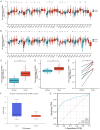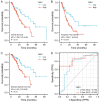The prognostic significance of FMR1 expression and its immunomodulatory implications in esophageal carcinoma
- PMID: 40134827
- PMCID: PMC11932061
- DOI: 10.62347/XVFP6530
The prognostic significance of FMR1 expression and its immunomodulatory implications in esophageal carcinoma
Abstract
Background: Esophageal carcinoma (ESCA) is deemed a highly lethal malignancy with a grim prognosis and stands as the fourth leading cause of cancer-related mortality. Recent research has revealed the potential crucial role of fragile X mental retardation 1 (FMR1) protein in tumor development and progression. However, the correlation between FMR1 and immune regulation in ESCA remains unclear. In this study, we aimed to assess the clinicopathological and prognostic significance of FMR1 expression, and its relationship with immune cell infiltration, immune biomarkers and the pathway involved in ESCA.
Methods: The Cancer Genome Atlas (TCGA) pan-cancer data and the Gene Expression Omnibus (GEO) database were used to analyze the expression of FMR1. The correlation between FMR1 and cancer stage, time-dependent survival curve and receiver operating characteristic (ROC) curve were performed using R package. Immune cell infiltration was assessed using the samples found in TCGA. Functional enrichment analyses were performed to investigate the potential signaling pathway and biological functions.
Results: FMR1 was upregulated in 7 tumors and downregulated in 4 tumors. Overexpression of FMR1 considerably associated with cancer stage and poor prognosis in ESCA. The ROC area was 0.745 and 0.830 for 3-year and 5-year respectively. FMR1 exhibited a positive correlation with common lymphoid progenitor and T cell CD4+ Th2, and a negative correlation with B cell memory, B cell plasma, endothelial cell, monocyte, neutrophil, T cell CD4+ Th1, and T cell CD4+ effector memory in ESCA. The enrichment analysis revealed FMR1 was primarily associated with cell development and predominantly enriched in immune-related pathways.
Conclusion: FMR1 may act as a prognostic biomarker for ESCA and participate in immune regulation in ESCA.
Keywords: Esophageal carcinoma; immune cell infiltration; immune regulation; prognosis.
AJCEI Copyright © 2025.
Conflict of interest statement
The authors state that they conducted the research without any commercial or financial relationships that could be considered a potential conflict of interest.
Figures





References
-
- Morgan E, Soerjomataram I, Rumgay H, Coleman HG, Thrift AP, Vignat J, Laversanne M, Ferlay J, Arnold M. The global landscape of esophageal squamous cell carcinoma and esophageal adenocarcinoma incidence and mortality in 2020 and Projections to 2040: new estimates from GLOBOCAN 2020. Gastroenterology. 2022;163:649–658. e2. - PubMed
-
- Waters JK, Reznik SI. Update on management of squamous cell esophageal cancer. Curr Oncol Rep. 2022;24:375–385. - PubMed
-
- Lam AK. Introduction: esophageal squamous cell carcinoma-current status and future advances. Methods Mol Biol. 2020;2129:1–6. - PubMed
-
- Niu C, Liu Y, Wang J, Liu Y, Zhang S, Zhang Y, Zhang L, Zhao D, Liu F, Chao L, Wang X, Zhang C, Song G, Zhang Z, Li Y, Yan Z, Wen Y, Ge Y, Zang Z, Feng W, Zhang H, Tao L, Nakyeyune R, Shen Y, Shao Y, Guo X, Miles T, Yang A, Liu F, Wang G. Risk factors for esophageal squamous cell carcinoma and its histological precursor lesions in China: a multicenter cross-sectional study. BMC Cancer. 2021;21:1034. - PMC - PubMed
-
- Sung H, Ferlay J, Siegel RL, Laversanne M, Soerjomataram I, Jemal A, Bray F. Global cancer statistics 2020: GLOBOCAN estimates of incidence and mortality worldwide for 36 cancers in 185 Countries. CA Cancer J Clin. 2021;71:209–249. - PubMed
LinkOut - more resources
Full Text Sources
Research Materials
